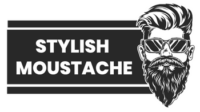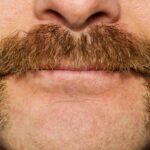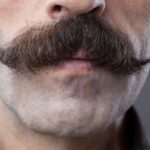
Growing and grooming a mustache and beard is a trend that has gained immense popularity in recent years. As facial hair styles evolve, there is a particular focus on connecting the mustache and beard seamlessly. This guide is perfect for beginners who want to achieve a well-groomed and connected look for their facial hair. I’ll walk you through different mustache styles, techniques for growing and grooming, shaping your beard, and essential tips for proper care and maintenance. Let’s get started!
Key Takeaways:
- Choose a mustache style that suits your face shape and personal preference.
- There are natural and thin mustache styles to consider, each with its own unique characteristics.
- Proper grooming and maintenance are crucial for a well-connected mustache and beard.
- Trimming and shaping beard lines help create a seamless transition between the mustache and beard.
- Regular beard care routines, including washing, conditioning, and combing, are essential for healthy facial hair.
Natural Mustache Styles
When it comes to mustache styles, going natural is a great option for those who prefer a low-maintenance look. Natural mustache styles are easy to grow and don’t require the use of styling aids, making them perfect for beginners. Let’s explore some popular natural mustache styles:
Chevron Mustache
The Chevron Mustache follows the natural shape of the upper lip, resembling an upside-down V. This timeless style exudes confidence and has been sported by many iconic figures throughout history.
Lampshade Mustache
The Lampshade Mustache gets its name from its trapezoid shape, similar to the shade of a lamp. This style is often associated with police officers and military personnel, giving it a strong and authoritative appearance.
Walrus Mustache
The Walrus Mustache is known for its length and fullness, as it engulfs the top lip and can even cover the bottom lip. This bold and distinctive style adds a touch of ruggedness to any look.
Painter’s Brush Mustache
The Painter’s Brush Mustache has the thickness of the Chevron Mustache but without the downward angle. It provides a clean and refined look, making it a popular choice among gentlemen who want a stylish mustache without excessive flair.
Toothbrush Mustache
The Toothbrush Mustache, famously worn by Charlie Chaplin, is a stubby mustache shaved on both sides to the approximate width of the nose. This unique style adds a touch of vintage charm and makes a statement wherever you go.
These natural mustache styles offer a variety of choices to suit your preferences and personality. Whether you opt for the classic Chevron Mustache, the authoritative Lampshade Mustache, the rugged Walrus Mustache, the clean Painter’s Brush Mustache, or the iconic Toothbrush Mustache, there’s a natural style that can complement your overall look. Explore these different styles and find the one that best reflects your individuality.
How to Grow and Groom a Mustache Style
To achieve your desired mustache style, it’s important to understand the process of growing and grooming a mustache. Whether you’re going for the Chevron Mustache, the Lampshade Mustache, or the distinguished Walrus Mustache, proper care and maintenance are essential for a well-groomed and stylish look.
Let’s begin with the first step – growing your mustache. It’s important to allow your mustache to grow naturally for a specific period of time, depending on the style you want to achieve. For the Chevron Mustache, two to three months of growth is recommended. The Lampshade Mustache typically requires one to two months, while the majestic Walrus Mustache requires a minimum of six months. Patience is key during this stage, as it allows your mustache to reach its full potential.
Once your mustache has grown to the desired length, it’s time to start the grooming process. Using Beard Trimming Scissors, carefully trim any longer hairs that disrupt the shape you’re aiming for. It’s important to follow specific guidelines for each style to ensure accuracy and precision. For example, for the Chevron Mustache, trim the hairs along the edges to create a clean, angular shape. The Lampshade Mustache requires trimming the hairs just below the middle of the upper lip, maintaining a consistent width. And for the Walrus Mustache, trim the hairs to create a full and bushy appearance.
When grooming your mustache, shaping the edges is crucial. Use your scissors to carefully shape the upper and lower edges of your mustache, removing any stray hairs that may affect the overall look. It’s also important to avoid having hair in your mouth, so make sure to trim any hairs that extend beyond your lips.
While some mustache styles may require the use of styling aids like Mustache Wax, it’s worth noting that natural mustache styles – such as the Chevron, Lampshade, and Walrus – can be shaped without any additional products. This makes grooming more straightforward and convenient, as you can achieve the desired look without the need for extra styling products.
Remember, growing and grooming a mustache takes time and dedication. With proper care and attention to detail, you can cultivate a mustache style that showcases your personal flair and adds a touch of sophistication to your overall appearance.
Thin Mustache Styles
When it comes to mustache styles, not all men prefer a thick and full look. Thin mustache styles are a great option for those who want a more refined and subtle facial hair aesthetic. Let’s explore two popular thin mustache styles: the Pencil Mustache and the Parted Pencil Mustache.
Pencil Mustache
The Pencil Mustache, popularized by legends of the silver screen like Clark Gable and Errol Flynn, is a classic and sophisticated choice. This thin and devilish style adds a touch of elegance to any look. The Pencil Mustache looks especially dashing when paired with formal attire or for special occasions.
Parted Pencil Mustache
The Parted Pencil Mustache puts a modern twist on the traditional Pencil Mustache. This style adds a distinguishing feature—a hard line at the philtrum, the indent above the upper lip. By incorporating this subtle detail, the Parted Pencil Mustache takes the sophistication of the Pencil Mustache to the next level.
To achieve both thin mustache styles, precise trimming is essential. Use scissors or electric trimmers to carefully shape and maintain your mustache. These styles look particularly striking on individuals with black or dark brown hair.
Whether you opt for the classic charm of the Pencil Mustache or the added flair of the Parted Pencil Mustache, these thin mustache styles are sure to make a refined statement.
How to Shape Your Beard for a Seamless Connection
To achieve a seamless connection between your mustache and beard, it’s important to shape and define your beard lines. By carefully trimming and grooming these areas, you can create a cohesive and stylish look. Here are the key beard shaping and grooming tips:
- Trimming the Cheek Line: Start by keeping the cheek line as high as naturally possible. This line should connect from the sideburn to the top of your mustache. Use a trimmer or scissors to create a clean and defined cheek line.
- Defining the Back Line: The back line runs off the back of the sideburn down to the bottom of your beard. Depending on personal preference, you can choose to square off the corner or round it. Trim the back line to create a neat and well-defined shape.
- Trimming the Neck Line: The neck line should be trimmed where the head connects to the neck, usually just above the Adam’s apple. This will help maintain a natural and full appearance. Use a trimmer or scissors to neatly shape the neck line.
Remember, beard shaping requires precision and attention to detail. Take your time and make small adjustments as needed to achieve the desired results. Regular grooming and trimming will help maintain the shape and keep your beard looking its best.
With these beard grooming tips and techniques, you can define your beard lines and achieve a seamless connection between your mustache and beard.
Trimming Tips for a Well-Maintained Beard
Once you have shaped your beard to perfection, it’s crucial to maintain its shape and appearance through regular trimming. Trimming your beard helps keep it neat and tidy, ensuring a well-groomed look that complements your mustache. To achieve this, here are some essential beard trimming tips to keep in mind:
- Frequency: The frequency of trimming depends on the length and style of your beard. Shorter beards generally require more frequent trims to keep them looking sharp.
- Caution is Key: Always trim with caution, taking small amounts off at a time. It’s better to make multiple passes with your trimmer or scissors rather than trimming too much at once.
- Tools of the Trade: You can use either electric trimmers or scissors for your beard trimming needs. Electric trimmers offer quick and effortless trims, while scissors provide more precision.
- Treating Your Beard Like a Hedge: Just like a well-manicured hedge, trimming down flyaway hairs helps tighten the overall shape of your beard.
To illustrate, think of your beard as a work of art that requires careful sculpting. By trimming regularly and paying attention to the details, you can maintain the shape and appearance of your beard. A well-groomed beard adds to the overall aesthetic appeal of your mustache and helps create a seamless connection between the two.
While the recommended frequency of trimming varies from person to person, trimming once a month is generally suitable for maintaining a well-groomed beard. However, if you are aiming for a shorter or more intricate beard style, you may need to trim more frequently to keep it looking its best.
Remember, a well-maintained beard adds an air of sophistication and confidence to your overall appearance. So, take the time to trim and care for your beard regularly, and enjoy the compliments that come with it.
The Importance of Proper Beard Care and Maintenance
Alongside trimming, proper beard care and maintenance play a crucial role in achieving a seamless connection between your mustache and beard. By implementing effective beard care tips, grooming techniques, and regular maintenance practices, you can enhance the overall appearance and connection between your mustache and beard.
Beard Care Tips:
- Regularly wash your beard with a mild cleanser to keep it clean and free from dirt and grime.
- Use beard oils or balms to moisturize and nourish your facial hair, promoting a healthy and soft texture.
- Combing or brushing your beard helps distribute the natural oils, reduces tangles, and keeps it looking well-groomed.
- Consider using beard-specific products, such as beard shampoo and conditioner, to maintain the health of your facial hair.
Beard Grooming Techniques:
- Regularly trim stray or split ends using beard trimming scissors or an electric trimmer to maintain a neat and uniform appearance.
- Shape your beard by defining the cheek line, back line, and neck line to create a well-groomed and balanced look.
- Experiment with different beard styles or lengths to find the one that best suits your facial features and personal style.
Proper beard maintenance is essential for keeping your facial hair looking its best. It’s important to follow a daily beard care routine and adjust it according to the length and style of your beard. By dedicating time and attention to beard care, you can ensure that your mustache and beard remain healthy, soft, and well-groomed, ultimately enhancing the overall appearance and connection between the two.
Final Thoughts on Connecting Your Mustache and Beard
When it comes to connecting your mustache and beard, there are a few key factors to keep in mind. Firstly, finding the right mustache style is crucial. Experimenting with different styles such as the Chevron Mustache, Lampshade Mustache, Walrus Mustache, Painter’s Brush Mustache, or Toothbrush Mustache can help you achieve the desired look. Each style has its unique growth and grooming requirements, so choose one that suits your face shape and personal style.
Secondly, shaping your beard lines is essential for a seamless connection. Trim your cheek line, back line, and neck line to create clean and defined edges. Keeping the cheek line high, connecting it to the top of your mustache, ensures a neat appearance. The back line should flow smoothly from the sideburns to the bottom of your beard, with the corner shaped to your preference. Finally, maintain a natural and full look by trimming the neck line just above the Adam’s apple.
Last but not least, proper beard care is vital for maintaining a well-connected mustache and beard. Regular washing, using beard oils or balms, and combing or brushing your beard help keep it healthy, soft, and well-groomed. Additionally, practicing precise trimming techniques and committing to a regular grooming routine will ensure your mustache and beard always look their best.
Remember, connecting your mustache and beard is a journey that requires patience and consistency. Mistakes may happen along the way, but don’t get discouraged. With the right mustache style, well-shaped beard lines, and diligent care, you’ll confidently rock a well-connected mustache and beard that suits your individuality.
FAQ
How do I choose a mustache style that works for me?
There are 17 unique mustache styles to choose from, including the Chevron Mustache, Lampshade Mustache, Walrus Mustache, Painter’s Brush Mustache, and Toothbrush Mustache. Consider the shape of your upper lip and the desired look you want to achieve.
What are the different natural mustache styles?
The natural mustache styles include the Chevron Mustache, Lampshade Mustache, Walrus Mustache, Painter’s Brush Mustache, and Toothbrush Mustache. These styles can be grown and groomed without the use of styling aids like Mustache Wax.
How can I grow and groom a mustache style?
To grow a mustache style, let your mustache grow naturally for a specific period of time and then use Beard Trimming Scissors to shape and groom it. Each mustache style has different growth and grooming requirements.
What are some examples of thin mustache styles?
Thin mustache styles include the Pencil Mustache and the Parted Pencil Mustache. These styles require precise trimming using scissors or electric trimmers.
How can I shape my beard for a seamless connection with my mustache?
To achieve a seamless connection, you should trim or shave the cheek line, back line, and neck line. The cheek line should be kept high, connecting from the sideburn to the top of the mustache. The back line runs off the back of the sideburn down to the bottom of the beard, and the neck line should be trimmed just above the Adam’s apple.
How often should I trim my beard to maintain its shape?
The frequency of trimming depends on the length of your beard style, with shorter beards requiring more frequent trims. Generally, trimming once a month is suitable for maintaining a well-groomed beard.
What is the importance of proper beard care and maintenance?
Proper beard care and maintenance help keep your beard healthy, soft, and well-groomed. Regular washing, using beard products such as oils or balms, and combing or brushing your beard are essential for maintaining its appearance.
Any final thoughts on connecting my mustache and beard?
Experiment with different styles, practice precise trimming, and commit to a regular beard care routine. Remember, it’s a journey, and with patience and consistency, you can confidently wear a well-connected mustache and beard.
- How to Grow a Dali Mustache: A Styling Guide for the Iconic Look - February 6, 2024
- Beginner’s Guide to the Chevron Mustache - February 6, 2024
- Beginner’s Guide to Connecting Your Mustache and Beard - February 6, 2024










